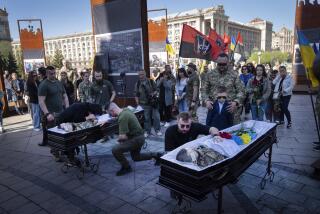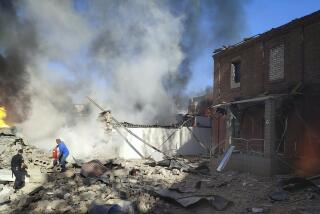U.N. Group Visits Iraqi Nuclear Compound
- Share via
TUWAITHA, Iraq — Representatives of the U.N. nuclear agency got a firsthand look Saturday at the postwar damage to Iraq’s main nuclear facility, peering through broken windows and roaming the grounds to assess the extent of looting and disarray.
The visit to the Tuwaitha nuclear research center was conducted under close watch by American officials, as is the entire mission by the International Atomic Energy Agency, or IAEA -- which aims to determine how much damage was done to the plant during the war and what went missing.
For three hours under a blazing afternoon sun, the U.N. team, accompanied by American weapons hunters, toured the grounds and looked into rooms where tons of uranium and radioactive sources had been safely stored for more than a decade.
Tuwaitha, Iraq’s largest nuclear facility and now defunct, was left unguarded for two weeks after Iraqi troops fled the area on the eve of the war.
U.S. troops didn’t secure the area until April 7. In the meantime, looters from the surrounding villages stripped it of uranium storage barrels they later used to hold drinking water. Villagers said the looting continued when the Marines handed over control to another unit in mid-April.
In preparation for the IAEA’s return, the U.S. military ordered villagers to sell back the barrels for $3 each. The Pentagon said the military had retrieved 100 barrels so far.
Some 3,000 barrels of low-grade uranium had been stored at Tuwaitha.
A U.S. team created to dismantle and eliminate any nuclear weapons found in Iraq has already conducted its own assessment of the site.
Col. Mickey Freeland, who heads that team, refused to say how much uranium he believes is now missing. “I’m not going to state what we did or didn’t find,” he said before heading out to the site with the IAEA team.
Another American colonel, Tim Madere, said some 20% of Tuwaitha’s uranium is unaccounted for.
Freeland’s team is accompanying the small group of seven IAEA members wherever it goes, and the military has placed the U.N. experts in a Baghdad hotel it is running. The Pentagon has said the military presence is meant to provide security and support, but the IAEA group wasn’t allowed to use neutral U.N. vehicles for transportation. Instead, they were taken to Tuwaitha in a bus driven by a U.S. soldier traveling in a 10-car military convoy.
The arrival of the U.N. group -- seven men, none of them American, whose expertise ranges from nuclear physics to weapons-control analysis -- marked the first time since the war began that representatives from the agency returned to Iraq.
The IAEA had long monitored Iraq’s nuclear programs and recently investigated claims by the Bush administration that Hussein was reviving his nuclear weapons program.
The head of the IAEA, Mohamed ElBaradei, said early on that there was no evidence to support Washington’s claims, and other U.N. inspectors found no signs of biological or chemical weapons.
More to Read
Sign up for Essential California
The most important California stories and recommendations in your inbox every morning.
You may occasionally receive promotional content from the Los Angeles Times.













